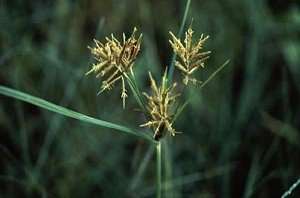About Yellow Nutsedge:This is a perennial plant where reproduction occurs through the spreading of their seeds and underground stems and tubers. Once this plant is established in an area, it has a high tolerance to weather and adapts easily to change. Family: Sedge Family (Cyperaceae)  
Yellow Nutsedge Scouting and Prevention:Yellow Nutsedge can be found in moist, sandy soil throughout North America. It is primarily located on roadsides, pastures, cultivated fields, gardens and lawns. This grass is easy to spot with a stem that sits at 10 to 19 cm in height and is triangularly shared with thin, tuber-bearing rhizomes. Yellow nutsedge has flowers that bloom from July to August with umbrella-like clusters of yellow to brown branches near the top of the stem. The best way to prevent Yellow Nutsedge from spreading is to make sure you have good, clean seeds when planting crops or gardens and clean all equipment that was used in contaminated areas. Do not spread manure that has Yellow Nutsedge in it. Yellow Nutsedge Control:During the growing season, it is very difficult to contain and control Yellow Nutsedge. A good way to keep this weed managed is to make sure you use crop competition. Mixing up what you plant in your fields will promote good cultural practices and improve crop health standards. For lawns and gardens, pulling this weed out will not be as effective as one would hope. When pulling out this weed, some of the tubers will be left behind. There are a few herbicides such as dichlobenel, dimethenamid-p and metolachlor to be applied before the weed emerges. Herbicides recommended for after the plant emerges is glyphosate, halosulfuron and penoxsulam. Here are a few steps that can help to control this particular weed:- - Do the recommendations given to you by the soil test
- - The field should be planted with high-yield varieties in narrow rows with high plant population as soon as ideal soil and weather conditions are met
- - Make sure to include soybeans and corn in your crop rotation. The herbicides used for these two plants provide greater control over the Yellow Nutsedge
- - Hay fields and pastures must be mowed regularly
Latin / Alternative Yellow Nutsedge names:- - Cyperus esculentus L.,
- - CYPES
- - Souchet comestible
- - Chufa
- - Earth almond
- - Ground almond
- - Northern nut-grass
- - Nut-grass
- - Rushnut
- - Yellow nut-grass
- - Amande de terre
- - Souchet rampant
Additional Yellow Nutsedge Resourceshttp://www.omafra.gov.on.ca/english/crops/facts/ontweeds/yellow_nutsedge.htm http://www.ipm.ucdavis.edu/PMG/PESTNOTES/pn7432.html http://extension.psu.edu/pests/weeds/control/controlling-yellow-nutsedge-in-agronomic-crops-an-integrated-approach |